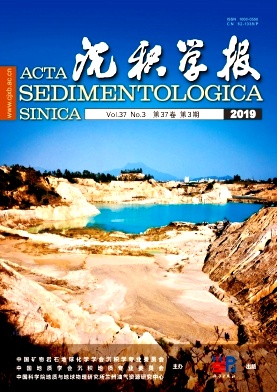Geochemical Characteristics of Site-4B Sediments from the Shenhu Area of the South China Sea: Implications for methane seepage
doi: 10.14027/j.issn.1000-0550.2018.144
- Received Date: 2018-04-23
- Rev Recd Date: 2018-06-04
- Publish Date: 2019-06-10
-
Key words:
- methane seepage /
- authigenic carbonate /
- Sr/Ca /
- Mg/Ca /
- South China Sea /
- gas hydrate
Abstract: Previous studies on Site 4B suggested the presence of methane seepage in this area. In this study, we systematically analyzed the particle size distribution, minerals, and chemical compositions of the sediments at an interval of 15 cm.
The particle size distribution varied significantly at a depth of 98 cm, which is ascribed to the changed hydrodynamic conditions. Significantly increased particle size was discovered at depths of 161 cm, 186 cm, and 213 cm. According to the sedimentation rate, these abnormally increased particle sizes occurred 24.15 ka, 27.47 ka, and 31.05 ka, which may be related to methane seeping events.The chemical compositions of the sediments changed with the particle size variation. At depths lower than 98 cm, the concentrations of CaO, Na2O, and Sr increased with depth, while that of SiO2, Al2O3, Fe2O3, Px dramatically decreased. At depths larger than 98 cm, on the contrary, these elements did not change significantly with depth. The positive correlations between CaO, Na2O, and Sr, as well as the negative correlations between these elements and SiO2 indicated that the carbonates (containing Ca and Sr) were affected by secondary processes, e.g., the production of authigenic carbonate from methane seepage.
The variation of the Mg/Ca and Sr/Ca ratios as a function of depth suggests that the sediment might be affected by mud volcanic activity before 15.78 ka. The mud volcanic activity arrived at a maximum at 35.96 ka, where the highest Mg/Ca and Sr/Ca ratios were measured. Furthermore, we calculated the relative contents of aragonite, high-Mg calcite, biogenic calcite, and detrital materials by using Bayon's model. The results indicate that the detrital materials likely originated from a stable source, while the calcite and aragonite were authigenic carbonates produced by microbial activities related to methane seepage. Combined with previous studies on pyrite and the particle characteristics of the sediments, we postulated that the methane seepage was related to the mud volcano activity before 15.78 ka. These periodic mud volcanic activities brought the deep-sourced methane to a shallow depth. Then the anaerobic oxidation of methane produced authigenic carbonates (including high-Mg calcite and aragonite). Strong methane seepage was observed at 24.15 ka, 27.47 ka, and 31.05 ka, where the maximum seepage occurred at 31.05 ka. At <98 cm (after 15.78 ka), however, the sediments were affected by both terrigenous inputs and methane seepage.
This study investigated the timing and intensity of methane seepagw in Site-4B using Mg/Ca and Sr/Ca ratios for the first time. It is important for unveiling the methane seeping history in the Northern SCS.
| Citation: | WANG JunYa, WU DaiDai, CHEN XueGang. Geochemical Characteristics of Site-4B Sediments from the Shenhu Area of the South China Sea: Implications for methane seepage[J]. Acta Sedimentologica Sinica, 2019, 37(3): 648-660. doi: 10.14027/j.issn.1000-0550.2018.144 |






 DownLoad:
DownLoad: